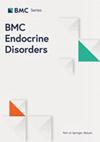开发并验证用于筛查 2 型糖尿病酮症酸中毒患者的提名图
IF 2.8
3区 医学
Q3 ENDOCRINOLOGY & METABOLISM
引用次数: 0
摘要
早期发现 2 型糖尿病(T2D)患者的糖尿病酮症酸中毒(DKA)对改善预后起着至关重要的作用。我们开发了一个用于筛查 T2D 患者 DKA 的提名图预测模型。同时,对输入变量进行了调整,以减少误诊。我们从 Mimic-IV V0.4 和 Mimic-III V1.4 数据库中获得了 T2D 患者的数据。我们利用训练数据集建立了一个提名图模型,进行了内部验证和敏感性分析,并利用航空总医院的 T2D 患者数据进一步进行了外部验证。根据建立的模型,我们分析了 1885 名 2 型糖尿病患者,其中 614 人患有 DKA。根据文献报道和多变量分析,我们进一步确定了 DKA 的风险因素。我们确定年龄、血糖、氯化物、钙和尿素氮为模型中的预测因素。逻辑回归模型的曲线下面积(AUC)为 0.86(95%CI:0.85-0.90]。为了验证该模型,我们收集了本医院 91 名 T2D 患者的数据,其中包括 15 名 DKA 患者。模型外部验证的 AUC 为 0.68(95%CI:0.67-0.70)。校准图证实我们的模型足以预测 DKA 患者。决策曲线分析表明,我们的模型为临床应用提供了净效益。我们的模型为预测是否存在 DKA 提供了一个方便、准确的工具。排除可能妨碍患者依从性的输入变量,提高了我们模型的实际应用意义。本文章由计算机程序翻译,如有差异,请以英文原文为准。
Development and validation of a nomogram for screening patients with type 2 diabetic ketoacidosis
The early detection of diabetic ketoacidosis (DKA) in patients with type 2 diabetes (T2D) plays a crucial role in enhancing outcomes. We developed a nomogram prediction model for screening DKA in T2D patients. At the same time, the input variables were adjusted to reduce misdiagnosis. We obtained data on T2D patients from Mimic-IV V0.4 and Mimic-III V1.4 databases. A nomogram model was developed using the training data set, internally validated, subjected to sensitivity analysis, and further externally validated with data from T2D patients in Aviation General Hospital. Based on the established model, we analyzed 1885 type 2 diabetes patients, among whom 614 with DKA. We further additionally identified risk factors for DKA based on literature reports and multivariate analysis. We identified age, glucose, chloride, calcium, and urea nitrogen as predictors in our model. The logistic regression model demonstrated an area under the curve (AUC) of 0.86 (95%CI: 0.85–0.90]. To validate the model, we collected data from 91 T2D patients, including 15 with DKA, at our hospital. The external validation of the model yielded an AUC of 0.68 (95%CI: 0.67–0.70). The calibration plot confirmed that our model was adequate for predicting patients with DKA. The decision-curve analysis revealed that our model offered net benefits for clinical use. Our model offers a convenient and accurate tool for predicting whether DKA is present. Excluding input variables that may potentially hinder patient compliance increases the practical application significance of our model.
求助全文
通过发布文献求助,成功后即可免费获取论文全文。
去求助
来源期刊

BMC Endocrine Disorders
ENDOCRINOLOGY & METABOLISM-
CiteScore
4.40
自引率
0.00%
发文量
280
审稿时长
>12 weeks
期刊介绍:
BMC Endocrine Disorders is an open access, peer-reviewed journal that considers articles on all aspects of the prevention, diagnosis and management of endocrine disorders, as well as related molecular genetics, pathophysiology, and epidemiology.
 求助内容:
求助内容: 应助结果提醒方式:
应助结果提醒方式:


